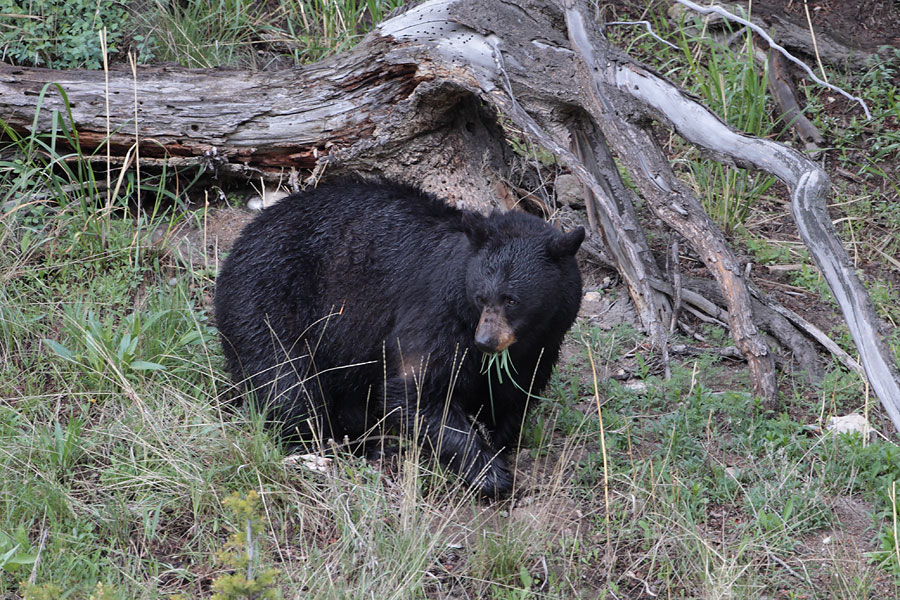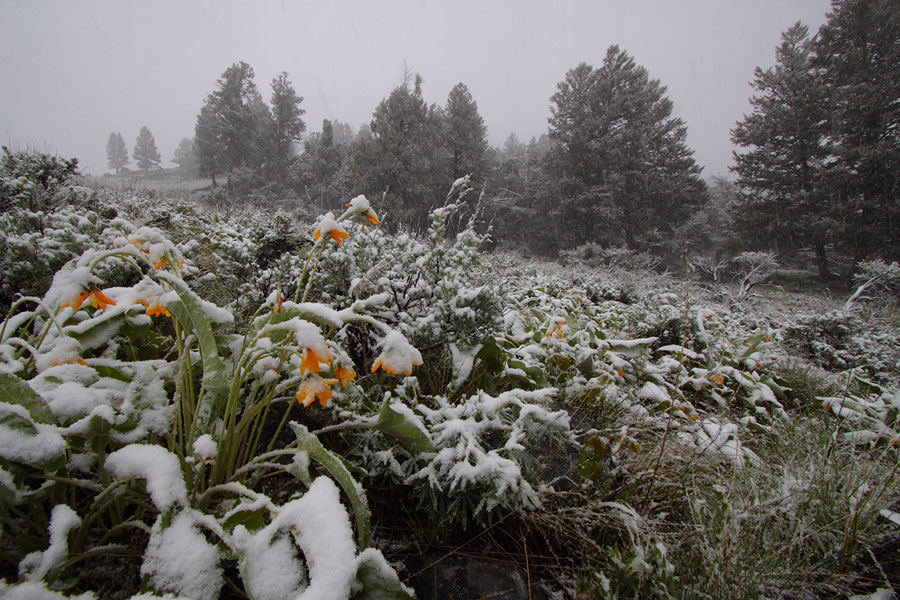|
|

Sunday:
Winter never leaves Yellowstone. It lies dormant, napping, popping up suddenly in spring or any other month, surprising us with its fat, wet snowflakes and cold, furious winds. Today we plunge into winter once again. At Tower Junction two grizzlies cavort on a hill across from the Ranger Station, two dark shadows wrestling under a white veil. Visibility is poor to nonexistent. It's hard to see them, though they are not far from the road.

The ground is dusted in white in Little America and Lamar Valley, while Pebble Creek and Round Prairie sit in an inch or two of snow and slush. Layers of fog and gray clouds descend to the roads, snow falling continuously.
The snow becomes heavier traveling east. A cow moose everyone has been talking about, injured with a calf, stands in the trees at the edge of Soda Butte Creek. She is so dark she fades into the black spots of the forest. Her calf is not there, or not visible. The cow stands still against the tree as the snow falls, not moving, conserving energy and protecting herself from the elements.
We cruise back and forth through Lamar Valley, driving very slowly. Bison parade across the road as cars try to herd them to one side or the other. Two bulls race down the steep hills north of Coyote turnout, snow flying behind them. What could have gotten into them?
We look for wolves. I heard yesterday that the Cottonwoods had a kill at Slough Creek, so we look there first. Nothing. In Lamar, cars are pulled to the side, east of the Institute, facing the hills north of the road. An elk looks back intently and a large black wolf suddenly appears and trots down the white slope, disappearing between berms.
 Our first wolf for this trip. He may be a Druid heading for the ridge trail, or maybe even Big Black, the mate of 694F, who was killed by the Cottonwoods. Tim thinks he saw a gray nearby that was out of sight quickly, which would make sense because Big Black has been hanging out with two Druid females, Dull Bar and 690F.
Our first wolf for this trip. He may be a Druid heading for the ridge trail, or maybe even Big Black, the mate of 694F, who was killed by the Cottonwoods. Tim thinks he saw a gray nearby that was out of sight quickly, which would make sense because Big Black has been hanging out with two Druid females, Dull Bar and 690F.
We return to Pebble Creek to watch the creek rush by. All the rivers and creeks are flooded with snowmelt, wildly crashing over rocks and fallen logs. The confluence is a huge marsh of sagebrush, tall grasses and water. The campsite is still closed due to snow. Tall lodge pole pines bend their branches, heavy with snow. We are pelted by clumps of snow, blown from the trees, as the sun tries to come out.
A flock of bluebirds lands on the road and in the sagebrush alongside. Against the snow, the males are striking with their bright turquoise color. We also see white crowned sparrows, a golden eagle and a sand hill crane.
There is a badger family denning in the rocks just off the road at Boulder. Four badger kits pop in and out of the den and waddle back and forth through the sage, not traveling more than four or five feet from the entrance. Their mother is absent right now, so they do not venture far.
On Tower Road, not far from the Roosevelt corrals, a small black bear - without eartags - forages in the grass along the road across from the pond. The sun comes out and it starts to rain. A ranger nearby calls the rain "bear fertilizer" because the bears come out when it rains.

An afternoon walk around the cabins brings us to the corral to visit the horses. There is such a variety of unusual horses - a black with white stripes and a half white mane, a buckskin with a dark brown and flaxen mane, a brown and white spotted horse with a face that's almost half white and half brown and a black tail. They remind me of the wild horses in the Prior Mountains.
This evening I walk to the Yellowstone River bridge. Just before I cross Tower Road a fox jumps into the meadow at the junction. All I see is a huge fluffy tail as the fox leaps into the sage. I try to find it, but it has disappeared. The sage is tall and thick and small, slender foxes can easily weave their way through without being seen. Where the road bends toward the bridge, a black bear ambles up the slope into the meadows on the east side. He seems larger than the bear we saw earlier, but he is also without eartags and could be the same bear.
How much the landscape changes in a matter of hours. This morning the ground was white and gray and now the green hills surrounding the cabins and rising above the Yellowstone River glow as the sun sets. The little stream that follows the Garnet Trail rumbles in the peacefulness of the evening. The only other sound is birds singing.
Author - Christine Baleshta
Photography - Tim Springer
 |
Click for larger image
|
|

